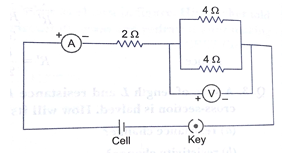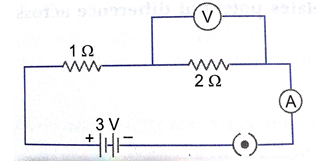Short Answer Questions - II - 3 Marks
Que 1. Why does an electric bulb become dim when an electric heater in parallel circuit is switched on? Why does dimness decrease after sometime?
Ans. The resistance of a heater coil is less than that of electric bulb filament. When heater is switched on in parallel, more current start flowing through the heater coil and current through the bulb filament decreases making it dim.
After some time, when heater coil becomes hot its resistance increases. As a result, current through the heater coil decreases and the current through the bulb filament increases and thus dimness of the bulb decreases.
Que 2. A metallic wire of resistance R is cut into ten parts of equal length. Two pieces each are joined in series and then five such combinations are joined in parallel. What will be the effective resistance of the combination?
Ans. The resistance of a conductor is directly proportional to the length of the conductor. The resistance of the metallic wire, when it is cut into ten parts of equal length is

Two such pieces when joined in series, the equivalent resistance of these two parts

Series resistance of two parts 

Hence 
Que 3. A wire of length L and resistance R is stretched so that its length is doubled and the area of cross-section is halved. How will its:
(a) resistance change?
(b) resistivity change?
Justify your answer in each case.
Ans. (a) Here, length is doubled and area of cross-section is halved. Thus, a wire of length l and area of cross-section A becomes a wire of length 2l and area of cross-section 

Using 
New resistance, 

i.e., resistance becomes four times
(b) Resistivity of a substance does not depend on its length or area of cross-section. It depends on the nature of the material and temperature. Hence there is no change.
Que 4. (a) The components of an electric circuit are 0.5 m long nichrome wire XY, an ammeter, a voltmeter, four cells of 1.5 V each, rheostat and a plug key. Draw a circuit diagram to study the relation between potential difference across the terminals X and Y of the wire and current flowing through it.
(b) State the law that relates potential difference across a conductor with the current flowing through it.
Ans. (a)

(b) Ohm's law states that the current through a conductor between two points is directly proportional to the potential difference across the two points.
Que 5. Draw a circuit diagram of an electric circuit containing a cell, a key, an ammeter, a resistor of Ω in series with a combination of two resistors (4 Ω each) in parallel and a voltmeter across the parallel combination, will the potential difference across the 2 Ω resistor be the same as that across the parallel combination of 4 Ω resistors? Give reason.

Ans. The circuit is shown in figure. Effective resistance of combination of two resistors (4 Ω each) in parallel is

Since the resistor of 2 𝛺 and parallel combination of two 4 𝛺 resistors are in series, same current will flow through these. Hence, the potential difference across 2 Ω resistor is same as that across combination of two resistors.
Que 6. Three incandescent bulbs of 100 W each are connected in series in an electrical circuit. In another circuit another set of three bulbs of the same wattage are connected in parallel to the same source.
(a) Will the bulb in the two circuits glow with the same brightness? Justify your answer.
(b) Now let one bulb in both the circuits get fused. Will the rest of the bulbs continue to glow in each circuit? Give reason.
Ans. (a) No.
Reasons: Let R be the resistance of each bulb, then total resistance in series = 3R
In series, current in each bulb is same.
So current drawn by each bulb connected in series is one-third as compared to the current in each bulb in parallel arrangement, so the bulbs connected in parallel combination glow more brightly.
(b) In series arrangement, if one bulb is fused; then current in the bulbs connected in series will become zero, so bulbs will stop glowing. In parallel arrangement, if one bulb is fused, the other two bulbs will continue to glow with same brightness.
Que 7. What would be the reading of ammeter and voltmeter in the given circuit?

Ans.

Ammeter reading = 1 A
Voltmeter reading = IR = 1 x 2 = 2 V
Voltmeter reading = 2 V
Que 8. Read the following information:
(i) Resistivity of copper is lower than that of aluminium which, in turn, is lower than that of constantan.
(ii) Six wires labelled as A, B, C, D, E, F have been designed as per the following parameters:
|
Wire |
Length |
Diameter |
Material |
Resistance |
|
A |
l |
2d |
Aluminium |
R1 |
|
B |
2l |
d/2 |
Constantan |
R2 |
|
C |
3l |
d/2 |
Constantan |
R3 |
|
D |
l/2 |
3d |
Copper |
R4 |
|
E |
2l |
2d |
Aluminium |
R5 |
|
F |
l/2 |
4d |
Copper |
R6 |
Answer the following question using the above data:
(a) Which of the wires has maximum resistance and why?
(b) Which of the wires has minimum resistance and why?
(c) Arrange R1, R3 and R5 in ascending order of their values. Justify your answer.
Ans. (a) Wire C has maximum resistance because it has maximum length, least thickness and highest resistivity.
(b) Wire F has the maximum resistance since it has least length, maximum thickness and least resistivity. 
(c) R3 
 and comparison)
and comparison)

